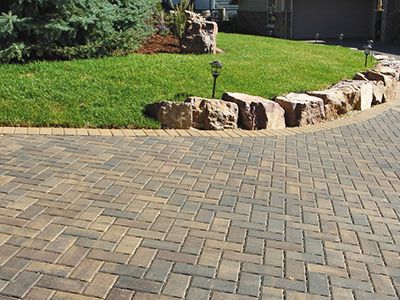The trend in landscaping today — throughout the world — is toward a more natural look. In addition, in practical terms, commercial landscapes must provide adequate streets and parking areas, easy, safe, and secure access to buildings, tasteful landscaping and lighting, and much more. While well-tended lawns and formal gardens were once the hallmark of tasteful surroundings, today that is only the beginning. Modern requirements for vehicles and pedestrians, environmental concerns, and a desire for sustainable, cost-effective, low-maintenance landscapes have changed the paradigm. Fortunately, the use of water permeable pavers in commercial landscapes is a way not only to create adequate drainage but also to ensure that outdoor areas are as beautiful as they are functional.
What are Permeable Pavers?
 The porosity of permeable paving systems allows water to drain into the substrate or soil below instead of ponding on the surface or causing unwanted runoff into adjacent areas. In Florida, quick tropical storms are not uncommon, but storm drains are not the norm in many areas. Flooding and runoff are a constant problem. Any surface that allows excess water to be absorbed as quickly as possible into the ground is considered desirable. When a desirable paving option is also attractive, it offers the best of all possible solutions.
The porosity of permeable paving systems allows water to drain into the substrate or soil below instead of ponding on the surface or causing unwanted runoff into adjacent areas. In Florida, quick tropical storms are not uncommon, but storm drains are not the norm in many areas. Flooding and runoff are a constant problem. Any surface that allows excess water to be absorbed as quickly as possible into the ground is considered desirable. When a desirable paving option is also attractive, it offers the best of all possible solutions.
Today, the best commercial landscapes often simulate surrounding open spaces, blurring the lines between developed land and native topography and greenery. A great deal of thought and planning goes into these contemporary landscapes, seeking to preserve and protect the natural environment, and to integrate the built environment into its natural surroundings. Creating this harmony is a task that professional landscape companies work hard to achieve. It requires creative solutions and innovative materials in order to preserve the desired balance between the practical and the beautiful.
Permeable paving systems, particularly those that integrate attractive components with purely practical ones, are advantageous. We are certain they will become the problem-solving components of future landscapes.
A Quick Guide to Paving Options
Many types of permeable pavers exist. The main categories of such materials are:
- Permeable Concrete: Although concrete can be mixed with stone and laid without a substrate to increase its porosity, it is an expensive option and typically not well-suited for large commercial applications. For smaller areas, however, and where vehicle use is limited, it is an option that encourages water absorption into the soil below. Its primary disadvantage is the relatively high cost and the need for routine upkeep and repairs.
- Porous Asphalt: Asphalt can be applied directly on top of a stone bed, allowing water to drain through the stone to the soil below. Like porous concrete, it is best used only for small areas, due to its fragility and a tendency to clog over time. Long-term maintenance is problematic, with potholes and ruts common.
- Interlocking Pavers: Concrete pavers and bricks, installed without mortar on a bed of sand or pebbles, are attractive, and water can easily pass through the small joints between pavers. The cost of installation is typically high, however, and the use of interlocking or mortarless pavers is usually restricted to residential applications or small commercial developments. It is not a good option for parking areas but can be very attractive for garden pathways or patios even in commercial settings.
- Plastic Grid Paving: Semi-flexible plastic grid that is available for heavy commercial and industrial use has cells of varying size that are designed to be filled with gravel or grass. This material moves to some extent with vehicle traffic, but it does not crack, retains its fill material well, and offers a high degree of permeability for maximum drainage. It offers low-maintenance, long-term use options at a reasonable cost.
- Rigid Plastic Pavers: A you would expect, rigid plastic is less forgiving than the more flexible grid, and its reduced flexibility is best in smaller-area applications that allow it to be filled with grass. Rigid grid pavers with hexagonal cells are among the most attractive options available and provide great visual impact if used in small areas.
- Rolled Plastic Paving Systems: Rolled systems can be easily shipped and are not difficult to install. The tradeoff is that the cells are quite small, and the material must be staked in place. It is used most often for areas limited to foot traffic. Its use also requires ongoing upkeep and maintenance to keep it in prime condition.
Some Benefits of Permeable Pavers
Cost may be a primary benefit of permeable paving solutions over traditional paving for commercial use. But the visual appeal is also a major factor that should influence its use in commercial development. Choose materials that strike a balance between aesthetics and effectiveness. When designing a comprehensive site plan, architects and landscape designers seek to achieve that balance, but also must comply with local requirements. Weighing the pros and cons of various materials requires looking at both price and function, as well as performance and maintenance. Water permeable pavers score well on all counts.
Code restrictions in various municipalities sometimes limit the amount of impervious surface on a specific project in an effort to minimize flood risk and prevent damage to natural waterways. The use of specially designed permeable pavers in specified areas is not only code-compliant, but environmentally friendly, cost-effective, and visually interesting.
ASI Landscape Management, with offices in Tampa and Orlando, is well-acquainted with distinctive Florida weather and well-aware that driving rains can wreak havoc with parking areas as well as gardens. Our landscape planners are quick to recognize the advantages of water permeable pavers that encourage water to drain directly into the ground below.
What Options Would You Like to Consider for Your Landscape?
We approach every design assignment with a blank page, open to using all the elements of architecture, nature, and modern landscape design to create commercial landscapes that complement their natural surroundings and meet the needs of a specific development. Our planners will work with you to identify different areas on your site and utilize them appropriately. Our capabilities include trees, gardens, ponds, fountains, pathways, parking areas, and other features that contribute individuality and appeal to their surroundings.
We invite you to browse our portfolio of completed projects throughout Florida. When you’re ready to talk about the possibilities on your unique site, give us a call.


